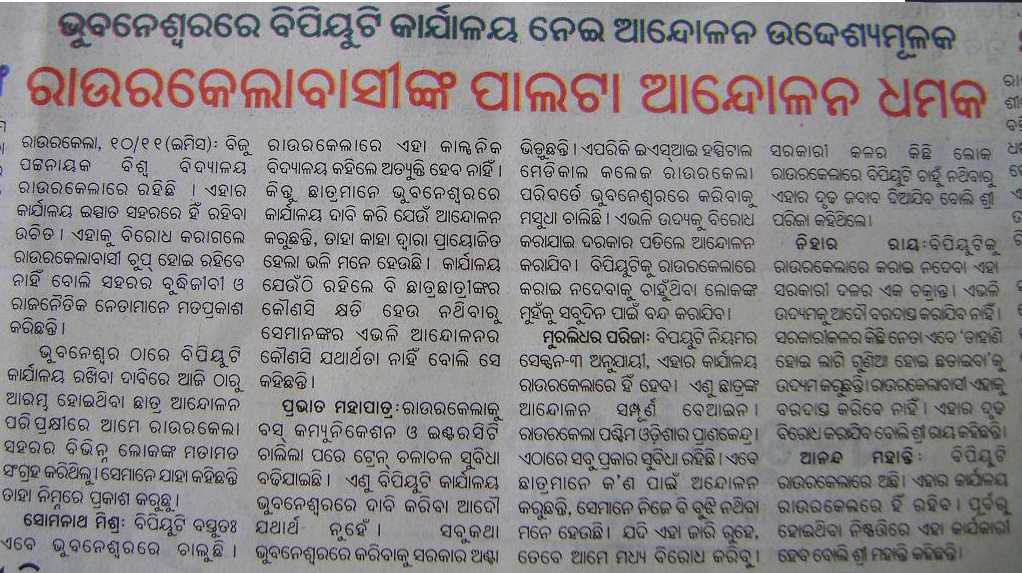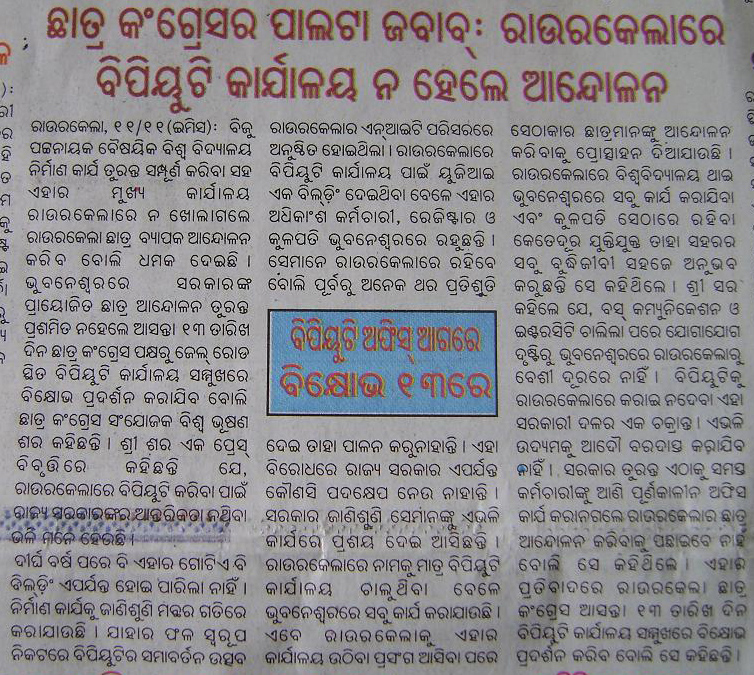Update: See also https://www.orissalinks.com/orissagrowth/archives/4308.
Rourkela is the second largest metropolitan area of Orissa with an official metropolitan population of 550,668 but perhaps much more (at least 700 K) if one takes into account nearby places like Biramitrapur and Rajgangpur. It is probably the most cosmopolitan area of Orissa. Because of its steel plant it has world-wide name recognition. It has a lot of young talents; I am told that Rourkela youngsters have done much better in entrance exams like IIT JEE than from other parts of Orissa. Rourkela and the Sundergarh district have produced many national hockey players (both male and female), some of whom have gone on to captain the Indian national side.
Being an important station in the Mumbai-Howrah line, Rourkela is very well connected to both. The National Institute of Technology at Rourkela is often ranked among the top 5 NITs of the country; in recent years it has done much better and is in the process of starting a business program. Rourkela also has two private engineering colleges and at least one more is in the works. Rourkela has at least two good magament schools: Rourkela Institute of Management Studies (sometimes ranked nationally) and Indian Institute of Production Management, Kansbahal.
Overall, Rourkela has the potential to be a Tier II city of India at the level of Vizag, Chandigarh, etc. But unfortunately, that has not happened so far and active organized efforts need to be made to achieve that.
So here I will list some of the things that should be pursued so that Rourkela becomes a Tier II city of India.
Knowledge and HRD aspects:
- Metropolitan University: Rourkela is perhaps the largest metropolitan area of the country, or may be the whole world which does not have a general university. This needs to be rectified at the earliest. IMHO, the best model to follow would be of Delhi University. So a Rourkela Metropolitan University should be established with graduate programs as well as with a few constituent colleges spread (offering Bachelors as well as Masters degrees) across the metropolitan area, but with no affiliated colleges. The exisiting government colleges in Rourkela (Govt. College, Rourkela; SG Women’s, Rourkela and Rourkela College) would be made constituents of this university.
- Medical College: Although a WODC sponsored PPP-based medical college is in the works, we must continue pursuing an ESIC medical college here. SAIL, which is making a medical college in Bokaro, should also be pushed to establish a medical college here.
- BPUT: BPUT must become fully operational from Rourkela.It needs to have real departments and centers and offer its own courses. It should be expanded to have programs in Science and Humanities.
- Research Centers: The state should pursue one of the central government departments such as CSIR, DAE, Sc & Tech, etc. to open a research center in Rourkela.
- Centrally funded University: At some point a centrally funded university should be pursued for Rourkela.
- More private institutions: Rourkela has the population base and the amenities that metropolitan areas offer to have more private institutions such as engineering colleges, management institutions etc. A multi-pronged apporoach should be taken.
- Local big industries should be cajoled to participate in this. For example, SAIL is also planning an engineering college in Bokaro. They should be pushed to have one in Rourkela.
- Local people should also open private institutions on their own.
- Educational foundations inside and outside state that have developed good private institutions should be approached and invited to open institutions in Rourkela. Inside Orissa, institutions like Silicon and NIST should be approached.
- STP: The STP at Rourkela should be expanded.
- IT/BPO: Because of the cosmopolitan nature of Rourkela, it would be a good place for BPO and call center operations. This should be pursued.
- Sports Institute/University: Sundergrah district is considered by many to be the Hockey cradle of India, both in men’s and women’s hockey. It has produced both Men’s and Women’s hockey team captains in Dilip Tirkey and Jyoti Sunita Kullu. Orissa government should pursue to establish a National Sports Institute (of the kind in Patiala) in Rourkela. It should include programs in physical training, coach training, official training etc. This would specially contribute in the enhancing the employment opportunities for Adivasis who constitute 50.74% of Sundergarh’s population.
Connectivity Aspects:
- Rail Connectivity -Trains: While the connectivity to Mumbai and Kolkata is marvelous, connectivity to other places needs improvement. Dilip has a good list of new trains needed for Rourkela at http://rourkelarail.wetpaint.com/page/DEMANDS. This list is:
- Rourkela-Bhubaneswar Intercity Express( Day Time)
- Rourkela-Berhampur Gajapati Express
- Rourkela-Secundarabad/Hyderabad Express
- Trains to New Delhi from Bhubaneswar via Rourkela OR Rourkela-Nizamuddin/New Delhi Express (Any extension of Ranchi-Hatia or Tatanagar trains will also work)
- Trains to Patna and Eastern U.P.
- Rail Connectivity-Others: The Talcher-Bimlagarh line must be fast-tracked.
- Roads: The 4-laning of the state highway 10 connecting Sambalpur and Rourkela must be expedited.
- Air Connectivity: Rourkela airport must be made functional with commercial flights at the earliest.
Metro area:
- A larger metropolitan area for Rourkela that includes Kansbahal and Rajgangpur in the west and Biramitrapur in the North must be formally established.
- The state government should pursue Rourkela to be included in JNNURM.
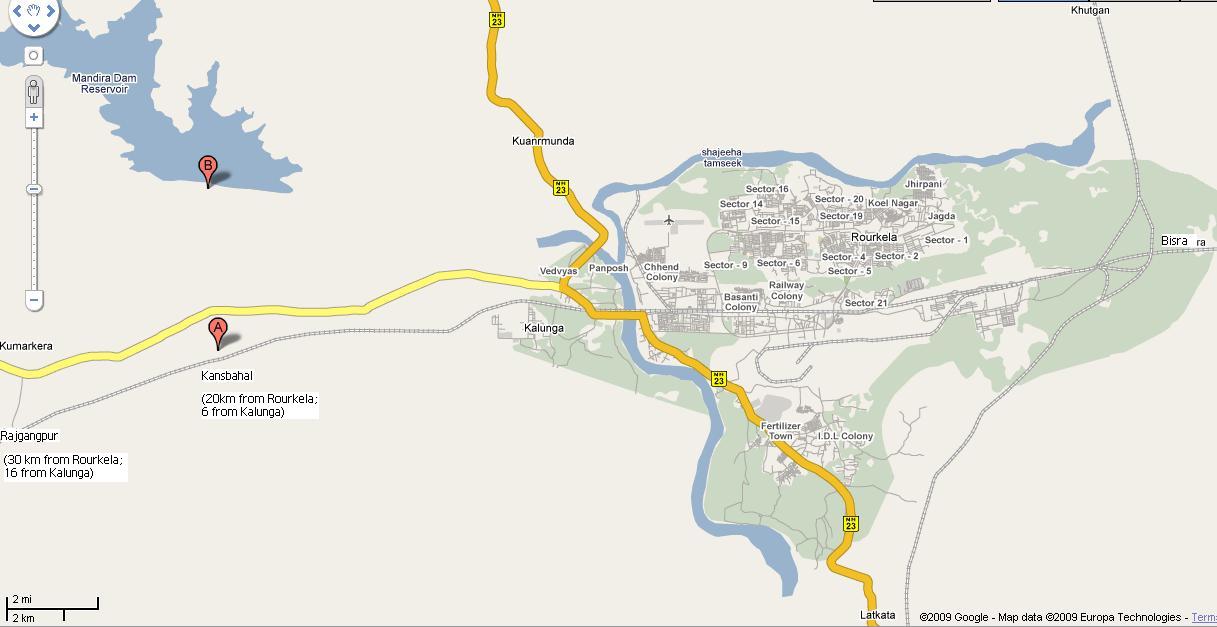
(The above is from Google Maps.)
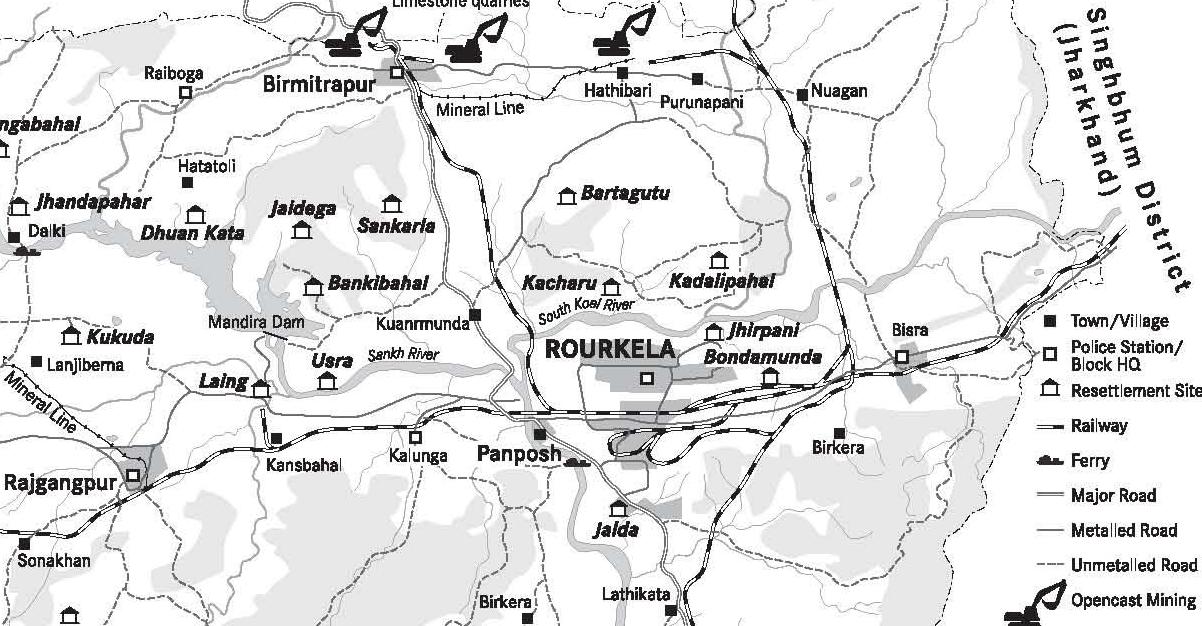
(The above is from "sarini: Occasional papers, No. 4, Adivasis of Rourkela")
Work in Progress…
November 15th, 2009
Following is an excerpt from a report in Pioneer. (A similar version also appears in tathya.in)
Leading non-resident Odia (NRO) Sandip Dasverma continues to bat for an ESI Medical College at Rourkela, though the State Government has turned a blind eye to the demand of the people of the steel city. Thanks to the alleged poor leadership of Rourkela, MLA Sarada Prasad Nayak, who is the Minister of Food and Civil Supplies, the demand has not been heeded by the Government. However, justifying his stand, Dasverma has come out with a detailed memo to the Government.
Dasverma says that Odisha’s development should take into account development of all regions of the State. But such a thought process is sadly missing, for which Rourkela as location of an ESI Medical College is being ignored. And this has resulted in regional resentment and regionalism, warned he.
He says Rourkela should have been recommended for the first ESI Medical College rather than the second by the State Government, as recently reported in the media. With Bhubaneswar being the destination of nine other medical colleges, one more would not mean much to the capital city whereas it would certainly matter a lot for Rourkela, which has none, he argues.
Dasverma further adds that Rourkela has the main concentration of Employees’ State Insurance (ESI) Insured persons, which is about 60 per cent, while the other 40 per cent live in and around Cuttack and Bhubaneswar. Rourkela should, therefore, get the priority as location of an ESI Medical College and Hospital, he strongly feels.
He points out that people of four districts, Sundargarh, Keonjhar, Jharsugda and Sambalpur would benefit due to an ESI Medical College and Hospital at Rourkela. Some more insured persons of the contiguous State of Jharkhand would also be benefitted.
He says Rourkela is the heart of Odisha’s tribal north-west and dotted with dirty mining industries.
The following two pieces appear in Sambada and Dainik Bhaskar. They have been obtained from http://www.odiasamaja.org/esic-medical-college-odia-samaja-odisa-development-teams-official-press-release/.
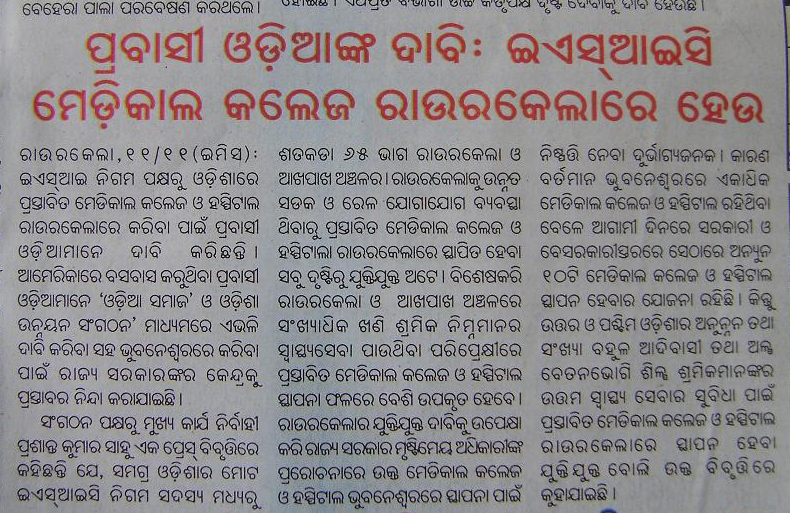
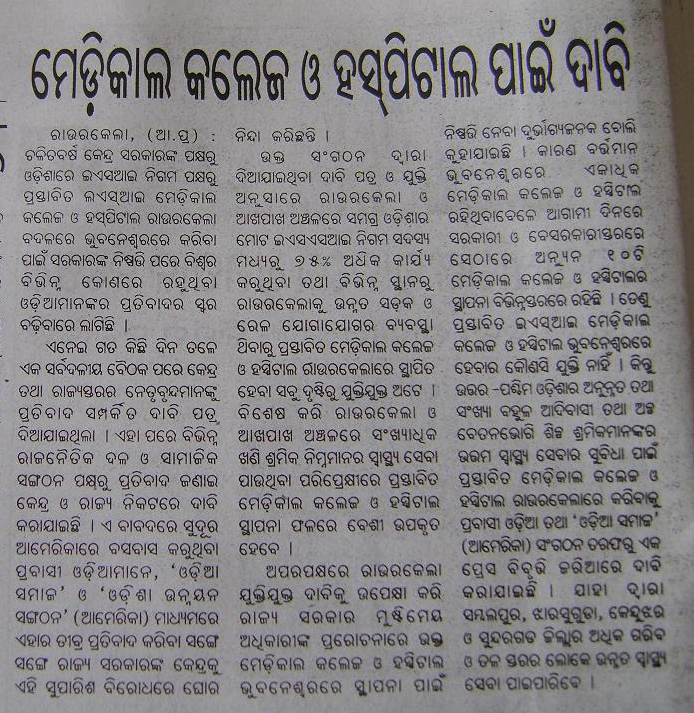
November 13th, 2009
The following two reports from Dharitri and Samaja are obtained from http://www.odiasamaja.org/more-media-coverage-esic-medical-college/.
From Dharitri:
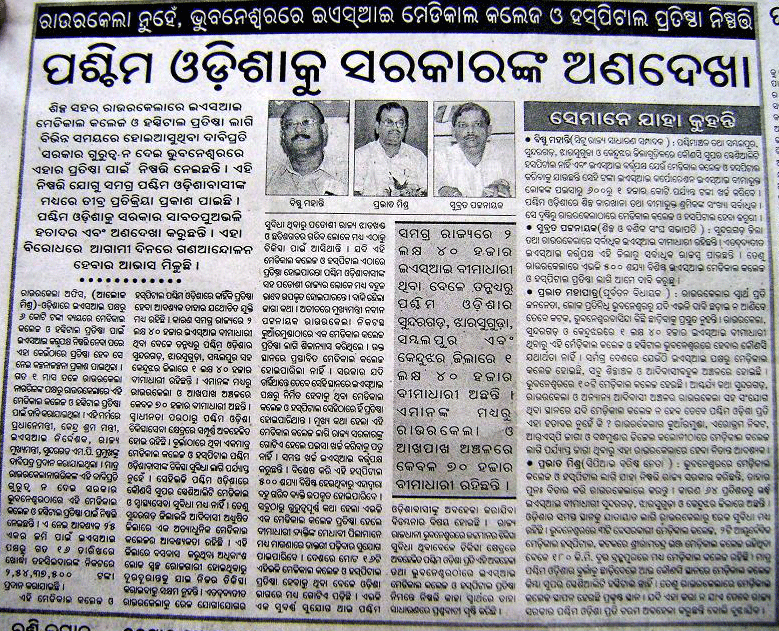
From Samaja:
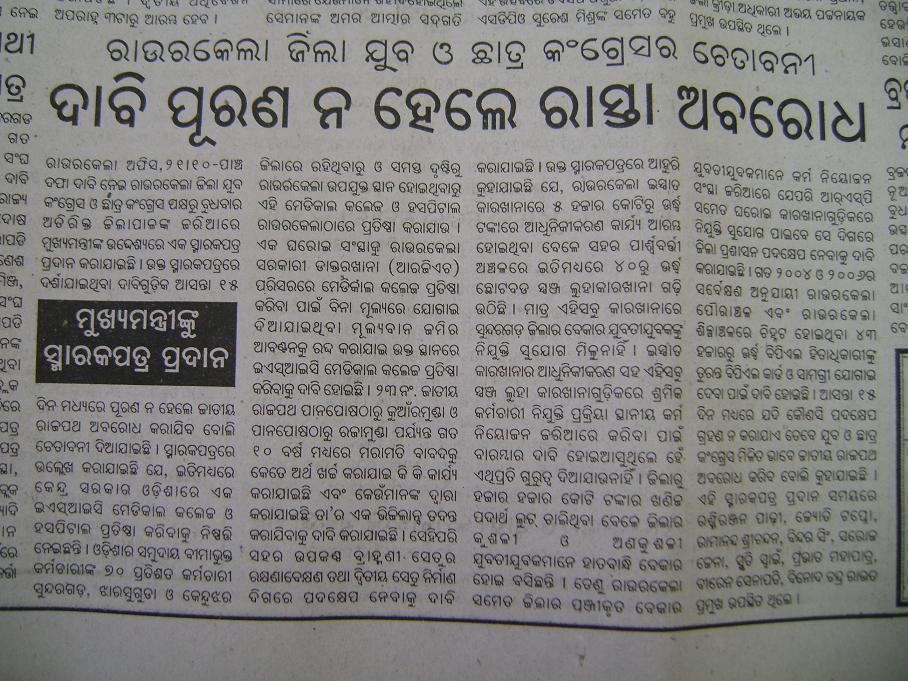
October 23rd, 2009
The following is from Samaja e-paper. (Sambada also reports on this.)
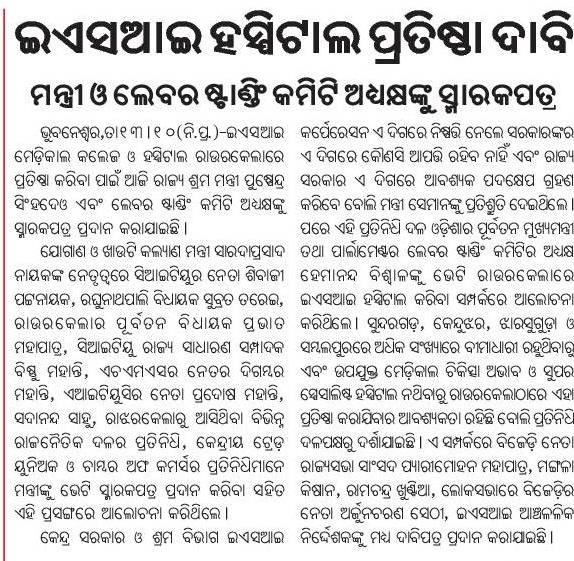
I think the situation is clear. All the biggies from Rourkela, including MLA and minister from Rourkela Mr. Sarada Nayak, are now publicly united on this. The Orissa government does not seem to have any opposition except that they don’t want to lose it out of Orissa. So what is needed is an indication from the center that they do not mind having it in Rourkela. However, such an indication needs to come very soon as other reports still mention about progress with respect to the Bhubaneswar location. (See also this report in expressbuzz.com.)
October 14th, 2009
The following list is based on the information in the page http://sctevtorissa.in/collegedetail.aspx?Cid=2 extracted today.
Bhubaneswar-Cuttack-Khurda-Puri area:
- BOSE, Cuttack
- DRIEMS, Tangi
- ITT, Choudwar
- Dhabaleswar Institute of Polytechnic, Athagarh
- Gurukrupa Technical School, Narsinghpur, Cuttack
- Kalinga Polytechnic, Bhubaneswar
- Nilachal Polytechnic, Bhubaneswar
- Women’s Polytechnic, Bhubaneswar
- Krupajal Engineering School, Bhubaneswar
- CV Raman Polytechnic, Bhubaneswar
- Koustav School of Engineering, Bhubaneswar
- CIPET, Bhubaneswar
- Bhubaneswar Polytechnic, Bhubaneswar
- Nalanda Institute of Technology, Bhubaneswar
- Suddhananda Residential Polytechnic, Phulnakhara
- Ganesh Institute of Engineering & Technology, Bhubaneswar
- Swami Vivekenanda School of Engineering & Technology, Bhubaneswar
- ARYAN INSTITUTE OF ENGINEERING TECH, Bhubaneswar
- Ideal School of Engineering, Retang, Khurdha
- Puri Engineering School, Puri
Berhampur area:
- SMIT, Ankuspur
- UCPES, Berhampur
- Women’s Polytechnic, Berhampur
- BSET, Berhampur
- Gandhi School of Engineering, Berhampur
- Aumasi Institute of Technical Education, Berhampur
- Kalam Institute of Technology, Berhampur
Koraput-Jeypore area:
- IEM, Jeypore
- Hi-Tech Institute of Information Technology, Jeypore
- Jeypore School of Engineering & Technology, Jeypore
- Siddhartha Institute of Engineering & Technology, Koraput
- SCSITM, Semiliguda
Rourkela area:
- Purusottam School of Engineering & Technology, Rourkela
- RIT, Kalunga
- SKDAV, Rourkela
- UGIE, Rourkela
Angul-Talcher-Dhenkanal area:
- IGIT, Saranga
- Pabitra Mohan Institute of Technology, Talcher
- KIMET, Chhendipada, Angul
- Women’s Polytechnic, Dhenkanal
- Orissa Institute of Engineering & technology, Dhenkanal
- Pathani Samanata Institute of Engineering & Technology, Dhenkanal
Jharsuguda-Sambalpur-Baragarh-Sundergarh area:
- JES, Jharsuguda
- BDSE, Brajarajnagar
- SES, Sundergarh
- PKAIET, Baragarh
Rayagada area:
- MITS INSTITUTE OF POLYTECHNIC, RAYAGADA
- UGMIT, Rayagada
Others:
- BSET, Barapada (Bhadrakh)
- BSE, Balasore
- MSE, Baripada
- SITE, Bolangir
- Kalahandi School of Engineering & Technology, Bhawanipatana (Kalahandi)
- Biju Patnaik Institute of Technology, Phulbani (Kandhamala)
- OSME, Keonjhar
- Sri Polytechnic, Komonda, Nayagarh
- Mahamaya Institute of Medical & Technology Science, Nuapada
October 11th, 2009
New Indian Express also reports on it; Tathya.in has yet another report on it; Pioneer also has another report on it.
(Thanks to Prasant Sahoo for the item below.)
The good part of this report is that BJD MLA Subrat Tarai chaired the meeting.
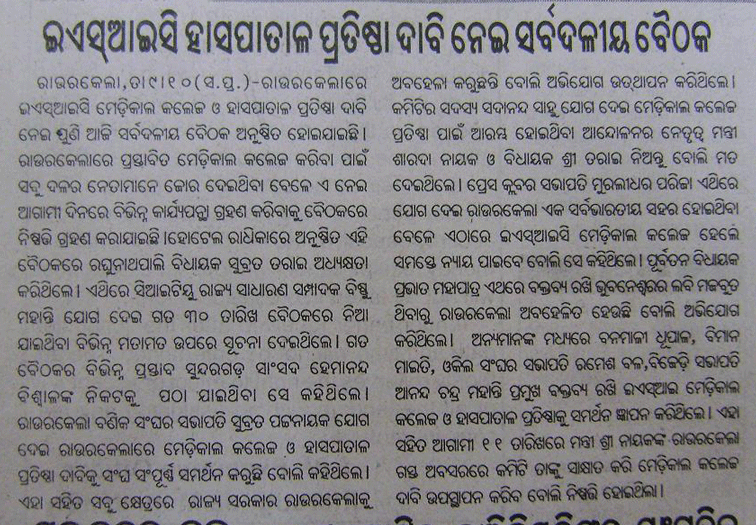
October 10th, 2009
Update: Various trade unions and local organizations in Rourkela have signed a joint memorandum. The details are at: http://www.odiasamaja.org/esic-medical-college-trade-unions-variour-organizations-support/.
Following is an excerpt from a report in Pioneer.
Hundreds of e-mails reached the Chief Minister’s Office (CMO) urging him to impress upon the Employees’ State Insurance Corporation (ESIC) for establishment of the college and hospital in the steel city. The Prime Minister and the Union Minister for Labour were flooded with mails and memorandums. Bur it seems nobody in the Government is bothered about the hue and cry raised by the people from various sections of the society.
“If there is any place fit for an ESIC Medical College & Hospital, it is Rourkela,” said a top Orissa Government official. Then how come the Government is silent over the demand and has allowed the ESIC to set up the college and hospital in Bhubaneswar? “You better ask the Chief Minister,” said the officer on the condition of anonymity. Now, as the ESIC has been allotted land on the outskirts of the capital city, chances of Rourkela seem remote, admitted the official.
Interestingly, when the people of Rourkela joined the bandwagon for demanding the medical college and hospital in the steel city, local MLA Sarada Prasad Nayak, who is the Minister for Food, Civil Supplies and Consumer Welfare remained silent. Similarly, Minister for Labour and Employment Puspendra Singh Deo, who also hails from Western Orissa, quietly favoured the college to come up in Bhubaneswar.
The ESIC will spend Rs 600 crore for the medical college and hospital, a dental college and a nursing college in the same campus, said sources. Officials point out that as there is no full-fledged airport near Rourkela, the Centre will not agree to setting up of a medical college there.
The mention about Rourkela not having airport and hence center may not agree is bogus. I don’t see any connection betweem an airport and an ESIC medical college. Indeed two other locations where ESIC medical colleges are being established do not have a nearby airport either. They are Gulbarga, Karnataka and Alwar, Rajasthan. (Thanks to Prashant babu for pointing to the second one.)
October 5th, 2009
Update: The following was written before I saw this article in Pioneer.
Tathya.in has a report on Dr. Digamabara Patra’s request for a national or central university in Bhawanipatna, Kalahandi. A lot of the arguments made there make sense. Many of the recent central universities have been established in rural and semi-urban areas and indeed there is no reason why one should not be established in Bhawanipatna; especially since its citizens have been asking for one for more than 2 decades.
However, as mentioned in the article https://www.orissalinks.com/archives/3229 adequate infrastructure seems to have been an important factor in determining the locations of the new IITs, IIMs and National universities.
For Orissa to have them in locations ouside of Bhubaneswar, there are two ways to go about it.
- Argue that adequate infrastructure should not be a requirement or they will automatically come once the institutions are established.
- Develop areas outside Bhubaneswar to have adequate infrastructure.
To me pursuing (2) has a higher chance of success than pursuing (1) and even if (1) is successful the institutes/universities in locations without appropriate infrastructure will struggle until the infrastructure eventually catches up which may take a long time if just left to fate. (Such a struggle may result in Orissa not being given in appropriate numbers additional central/national institutes.)
[In India people sometime point out that IIT Kharagpur was established in a rural location. First, Kharagpur is only 116 kms from Howrah. Second it has been a major railway junction for a long time. Third it was the first IIT and for a long time only one of 5 IITs. Similarly Roorkee was the oldest engineering college and is close to Haridwar and Dehradun. There are a few top universities and institutions in the US that are in rural areas, but these are exceptions, and the infrastructure in rural areas of US are quite good compared to rural areas of India. For example, Univ of Illinois at Urbana Champaign and Penn State University in State College, PA are often mentioned in that context. But both do have small airports with commercial flights.]
Before we suggest what needs to be done regarding developing areas outside Bhubaneswar to have adequate infrastructure, let us address what may be coming in the future and why Orissa needs to do this urgently so as to not risk missing future allocations of national institutions.
The National Knowledge Commission (NKC) in its December 2006 note on higher education has explicitly suggested 50 national universities in India. It says:
We recommend the creation of up to 50 National Universities that can provide education of the highest standard. As exemplars for the rest of the nation, these universities shall train students in a variety of disciplines, including humanities, social sciences, basic sciences, commerce and professional subjects, at both the undergraduate and post-graduate levels. The number 50 is a long term objective. In the short run, it is important to begin with at least 10 such universities in the next 3 years. It is worth noting that the National Universities need not all be new universities. Some of the existing universities could also be converted into National Universities, on the basis of rigorous selection criteria, to act as exemplars. We recognise that there could be a human resource constraint if faculty members are not available in adequate numbers to establish these universities.
The current government has implemented most of the recommendations of the NKC and exceeded some of them. For example, instead of the recommendation of 10 national universities in the three years following the report (2007-2010), establishment of 14 have been announced. Moreover, the higher education budget has been increasing drastically from one five year plan to the next. The 12th five year plan starts in 2012 and it is expected that it will take up on the long range objectives of the knowledge commission. In other words there could and should be more central and national universities in the 12th plan.
[My impression is that how soon additional national universities are established will depend on the success of the first 14. It seems to me that the locations of the first 14 have been greatly influenced by the consideration of, where in each of the states selecetd, does it have the best chance to succeed.]
Unless Orissa is prepared for it, Orissa may lose out pieces of those plans on lack of infrastructure grounds. Other states with multiple locations with adequate infrastructure will get preference and Orissa may lose out.
However, 2012 is still 3 years away and if adequate steps are taken very soon, Orissa should be able to get its fair share.
The pity is there are areas in Orissa which are on the verge of having the necessary infrastructure, mostly through private investment, but because of non-constructive opposition, blind suspicion towards industrialization and the relcucatnce of many to speak out in favour of development and industrialization, the development and associated infrastructure building has been greatly hampered. The governments (state and center) are also at fault for their sluggishness on some aspects.
Following are some suggestions:
- The state government should push for the completion of the airport in Jharsuguda within a year.
- It should make an all-out effort to have commercial flights operating out of the existing airport in Rourkela. In general, the people of the area need to recognize the existing infrastructure and potential of Rourkela and take advantage of it. Currently, as a friend of mine would say, Rourkela is an orphan. This is a pity. It is a big asset to Orissa, especially to the western parts of Orissa; but is severely underutilized and undermined.
- Coming back to Jharsuguda, the people there should follow a smarter approach in not opposing and rather facilitating industries coming up there, and at the same time being vigilant about environmental and land acquisition related R & R issues. If these industries and investment are allowed to materialize there soon, then Sambalpur-Jharsuguda area would become a large metro with adequate infrastructure to have and support any and all kinds of institutes and universities. But will the people do that? Or will they continue to be controlled by or scared of the anti-industry activists.
- Similarly, both Bhawanipatna (Lanjigarh to be precise) and Rayagada areas have industrial investors who have been senselessly opposed. If the people would take a smarter approach that mixes development with being vigilant about environmental and land acquisition related R & R then both these areas would be able to get infrastructure where a central university (and possibly more) would flourish. But will the people do that? Or will they continue to be controlled by or scared of anti-industry activists. In Lanjigarh, Kalahandi, the local MP has recently taken a more sensible approach. I hope there is a quick resolution as this area desperately needs development and the resulting infrastructure.
- The state government should push for the rail infrastructure, particularly, the Khurda-Balangir line, the Talcher-Bimlagarh line and connectivity to Kalahandi, to be completed at the earliest.
The above is extremely important for the development of the western parts of Orissa where there is often a feeling of neglect. If the people there do not follow a smarter approach and only follow the strange approach that many (not all) seem to be following (such as opposing industrialization and thus infrastructure building but wanting things that need infrastructure) the places that follow a smarter approach (inside and outside Orissa) would be gainers. The same is happening in some other places in Orissa too – Paradeep and Kalinganagar come to mind, but these places are in closer proximity to Bhubaneswar and because of that they may be less harmed.
October 4th, 2009
Update on 27th April 2011: The Central University location has been changed to Bander Sindri near Ajmer and only 80 kms from Jaipur. The Innovation University (previsouly referred to as National University) aiming for world class is now pushed for Jaipur. [Times of India].
Tathya.in has a report that mentions some official saying that because of the lack of an airport in Rourkela central government will not agree to have ESIC medical college in Rourkela. I think this is a completely frivolous argument; I don’t see much connection between an ESIC medical college and an airport. (Often airport is a codeword for adequate infrastructure. If that is the case Rourkela indeed has the infrastructure for an ESIC medical college.)
However, in regards to certain centrally funded institutions, such a requirement is in the background and mentioned by journalists, even if they may not be spelled out explicitly. So while pushing for an ESIC medical college in Rourkela, we should set our target to push for more functioning airports as a next action item. Following is a more detailed analysis.
Given below are the locations of some national institutions and some related attributes. It is easy to see that for the locations of IITs, IIMs and National Universities being near (say within 120 kms or 2 hrs) an operational airport has been an important factor. For national universities, in addition being in a large (1 million plus metropolitan area) area with other research institutes has also been spelled out as an important criteria and it is reflected in the locations that are picked.
On the other hand, the newly established central universities are in towns of all sizes and the locations of the NITs are mixed. The next level centrally funded but locally focused technological institutes, SLIET, Longowal, ABAGKC IET, Malda and Central Institute of Technology, Kokrajhar are on purpose established in rural areas and smaller towns. Unlike the NITs these institutions take only local students and also have programs focused on local needs. Nevertheless, their quality need not be bad. For example, SLIET is considered quite good.
Looking to the future following are some points relevant to Orissa.
- For Orissa to have future central institutions like IIM, SPA, etc. to be in a location outside of Bhubaneswar, Orissa must push for the quick establishment of airports and other infrastructure in other parts of the state. For example, the airports in Jharsuguda and Rourkela are the closest to be operational and they should have scheduled flights at the earliest. Otherwise new centrally funded institutions may again be established near Bhubaneswar and crying hoarse after the fact may not be productive.
- Similarly the knowledge commission has proposed the establishment of 50 national universities in the long run. Considering that the education budget significantly increases from one 5 yr plan to the next, I would not be surprised if there is another set of them made during the 12th plan. Orissa must be prepared for that and by that time (there is a short window) have other areas in Orissa with adequate infrastructure that are being deemed necessary for a national university.
- Orissa must take advantage of the industrial and investment interests in Orissa, mostly due to its minerals, and develop metropolitan areas with larger population base. Currently the local people are creating roadblocks rather than helping in such development.
- In 2010 we should do our best to convince the planning commission, the PM and MHRD that the 12th plan (starting 2012) should include more centrally funded institutions of the kind that can be located in rural or semi-urban areas. In particular,
- A centrally funded but locally focused technological institute (like SLIET) in all states. The one in Orissa could be located in Kalahandi or Balangir, the other two KBK districts that lack centrally funded institutions.
- Two regional universities in each major states that are funded 50-50 by the state and the center. (This would be better than one centrally funded institute.)
- Multiple branches of Indira Gandhi National Tribal University in districts with high tribal population.
The NITs.
| City/Town |
State |
Population of city/town |
Population rank |
| Delhi |
Delhi |
18,639,762 |
2 |
| Surat |
Gujarat |
3,196,799 |
10 |
| Jaipur |
Rajasthan |
3,102,808 |
11 |
| Patna |
Bihar |
2,656,318 |
13 |
| Nagpur |
Maharashtra |
2,569,775 |
14 |
| Bhopal |
MP |
1,751,766 |
17 |
| Allahabad |
UP |
1,272,612 |
31 |
| Jamshedpur |
Jharkhand |
1,252,815 |
33 |
| Srinagar |
J & K |
1,104,489 |
41 |
| Calicut |
Kerala |
1,000,802 |
46 |
| Tiruchirapalli |
Tamil Nadu |
963,237 |
49 |
| Jalandhar |
Punjab |
958,854 |
50 |
| Raipur |
Chhatisgarh |
795,104 |
56 |
| Dehradun |
Uttarakhand |
738,889 |
57 |
| Warangal |
Andhra Pradesh |
656,298 |
61 |
| Surathkal, Mangalore |
Karnataka |
612,374 |
66 |
| Pudducherry |
Pudducherry |
575,027 |
71 |
| Rourkela |
Orissa |
550,668 |
75 |
| Durgapur |
West Bengal |
543,922 |
77 |
| Shillong |
Meghalaya |
304,596 |
136 |
| Aizawl |
Mizoram |
295,864 |
140 |
| Imphal |
Manipur |
279,679 |
147 |
| Agartala |
Tripura |
218,028 |
184 |
| Silchar |
Assam |
209,543 |
193 |
| Kurukshetra (Thaneswar) |
Punjab |
157,609 |
249 |
| Panaji |
Goa |
142,336 |
271 |
| Kohima |
Nagaland |
103,210 |
407 |
| Gangkot |
Sikkim |
32,483 |
|
| Hamirpur |
Himachal Pradesh |
17,219 |
|
The IITs.
| City – Metropolitan area |
State(s) |
Metro population |
Metro rank |
State or country Capital |
Rank in state |
Number 1 in the state |
Nearest airpot |
Preferred airport |
| Bombay |
Maharashtra |
21347412 |
1 |
Yes |
1 |
picked |
in area |
same |
| Delhi |
UP, Delhi, Haryana |
18639762 |
2 |
Yes |
1 |
picked |
in area |
same |
| Chennai |
Tamil Nadu |
7305169 |
4 |
Yes |
1 |
picked |
in area |
same |
| Hyderabad |
Andhra Pradesh |
6290397 |
6 |
Yes |
1 |
picked |
in area (60 kms away) |
same |
| Gandhinagar – Ahmedabad |
Gujarat |
5334314 |
7 |
Yes |
1 |
picked |
Ahmedabad (40 kms) |
same |
| Kanpur |
Uttar Pradesh |
3494275 |
9 |
No |
1 |
picked |
in area (only Air India) |
Lucknow (80 kms) |
| Patna |
Bihar |
2656318 |
13 |
Yes |
1 |
picked |
in area |
same |
| Indore |
Madhya Pradesh |
2049193 |
15 |
No |
1 |
picked |
in area |
same |
| Bhubaneswar |
Orissa |
1666429 |
22 |
Yes |
1 |
picked |
in area |
same |
| Guwahati |
Assam |
1038071 |
44 |
Yes |
1 |
picked |
in area |
same |
| Ropar – Chandigarh |
Punjab |
1033671 |
45 |
Yes |
3 |
Ludhiana (19) |
Chandigarh (60 kms away) |
same |
| Jodhpur |
Rajasthan |
987919 |
47 |
No |
2 |
Jaipur (11) |
in area |
same |
| Kharagapur |
West Bengal |
511303 |
82 |
No |
5 |
Kolkata (3) |
Kolkata (120 kms away) |
same |
| Roorkee – Haridwar |
Uttarakhand |
250645 |
166 |
No |
2 |
Dehradun (57) |
Dehradun (1 hr away) |
Delhi (180 kms) |
| Mandi |
Himachal Pradesh |
32014 |
|
No |
3 |
Shimla (194) |
Kullu-Manali airport (60 kms away) |
same |
National Universities
| City – Metropolitan area |
State(s) |
Metro population |
Metro rank |
State or country Capital |
Rank in state |
Number 1 in the state |
Airport with scheduled flights |
Other airport nearby |
| NOIDA – Delhi |
UP, Delhi, Haryana |
18639762 |
2 |
Yes |
1 |
picked |
yes |
|
| Kolkata |
West Bengal |
15414859 |
3 |
Yes |
1 |
picked |
yes |
|
| Gandhinagar – Ahmedabad |
Gujarat |
5334314 |
7 |
Yes |
1 |
picked |
yes |
|
| Pune |
Maharashtra |
5273211 |
8 |
No |
2 |
Mumbai (1) |
yes |
|
| Jaipur |
Rajasthan |
3102808 |
11 |
Yes |
1 |
picked |
Yes |
|
| Patna |
Bihar |
2656318 |
13 |
Yes |
1 |
picked |
yes |
|
| Bhopal |
Madhya Pradesh |
1751766 |
17 |
Yes |
2 |
Indore (15) |
yes |
|
| Bhubaneswar |
Orissa |
1666429 |
22 |
Yes |
1 |
picked |
yes |
|
| Coimbatore |
Tamil Nadu |
1644224 |
23 |
No |
2 |
Chennai (4) |
yes |
|
| Kochi |
Kerala |
1541175 |
24 |
No |
1 |
picked |
yes |
|
| Visakhapatnam |
Andhra Pradesh |
1511687 |
26 |
No |
2 |
Hyderabad (6) |
yes |
|
| Mysore |
Karnataka |
1230039 |
34 |
No |
2 |
Bangalore (5) |
New airport but no scheduled flights yet |
140 kms from Bangalore |
| Amritsar |
Punjab |
1206918 |
36 |
No |
2 |
Ludhiana (19) |
yes |
|
| Guwahati |
Assam |
1038071 |
44 |
Yes |
1 |
picked |
yes |
|
New Central Universities
| City – Metropolitan area |
State |
Metro population |
| Gandhinagar – Ahmedabad (temporary?) |
Gujarat |
5,334,314 |
| Srinagar |
J & K |
1,104,489 |
| Khunti, Ranchi |
Jharkhand |
1,066,449 |
| Jammu |
J & K |
690,924 |
| Bikaner (Changed to be in Bander Sindri, near Ajmer, 80 kms from Jaipur) |
Rajasthan |
624,577 613,293 |
| Gulbarga |
Karnataka |
534,417 |
| Sagar |
Madhya Pradesh |
351,537 |
| Bilaspur |
Chhatisgarh |
319,129 |
| Bathinda |
Punjab |
269,520 |
| Koraput-Sunabeda-Jeypore |
Orissa |
200,000 |
| Motihari |
Bihar |
121,475 |
| Tiruvarar |
Tamil Nadu |
61,270 |
| Kasaragod |
Kerala |
52,683 |
| Tehri Garhwal |
Uttarakhand |
25,425 |
| Mahendragarh |
Harayana |
23,977 |
| Kangra |
Himachal Pradesh |
9,155 |
IIMs
| City – Metropolitan area |
State |
Metro population |
Airport |
| Kolkata |
West Bengal |
15414859 |
in area |
| Bangalore |
Karnataka |
6466271 |
in area |
| Ahmedabad |
Gujarat |
5334314 |
in area |
| Lucknow |
Uttar Pradesh |
2991280 |
in area |
| Indore |
Madhya Pradesh |
2049193 |
in area |
| Ranchi |
Jharkhand |
1066449 |
in area |
| Kozhikode |
Kerala |
1000802 |
in area |
| Tiruchirapalli |
Tamil Nadu |
963237 |
in area |
| Raipur |
Chhatisgarh |
795104 |
in area |
|
Dehradun
Kashipur
|
Uttarakhand |
738889
92978
|
in area
72 km away in Pantnagar
|
| Udaipur |
Rajasthan |
456994 |
in area |
| Rohtak |
Haryana |
340319 |
71 kms from Delhi |
| Shillong |
Meghalaya |
304596 |
in area |
October 4th, 2009
Following is an excerpt from a report in Expressbuzz.com.
The Orissa unit of CITU with support from mainstream political parties has renewed the demand to set up the proposed medical college and hospital (MCH) of the Employees’ State Insurance Corporation (ESIC) at Rourkela. An action committee formed today at an all-party meeting resolved to put pressure on the State Government to pave way for locating the MCH at Rourkela having high concentration of ESIC insured persons (IPs).
… Led by Orissa unit CITU general secretary Bishnu Mohanty, the meeting pointed out that of the 2.4 lakh IPs across Orissa, the industrial and mining district of Sundargarh along with adjacent Keonjhar, Jharsuguda and Sambalpur districts account for 1.4 lakh IPs. Hence, there is no justification in locating the MCH in Bhubaneswar which has a number of MCHs and super specialty hospitals, the meeting observed.
Following is an excerpt from a report in Pioneer.
Resentment is growing among the Rourkelites, with the Government’s decision of setting up an ESIC Medical College and Hospital in Bhubaneswar. Irrespective of party affiliations, a forum has come up to pursue Naveen Patnaik to relocate the ESIC Medical College here.
On this issue, an all-party meeting was convened in the district committee office of CITU on Wednesday under the chairmanship of Rourkela Press Club president Muralidhar Parija. Among others, CITU State general secretary Bishnu Mohanty, former Rourkela Congress MLA Pravat Mohapatra, Rourkela BJD president Ananda Mohanty, former Rourkela Municipal chairman and president Rourkela Bar Association Ramesh Bal, CPI(M) Sundargarh district committee secretary Banamali Dhupal, CITU leaders Biman Maity, Jahangir Ali, CPI leaders Pravat Mishra, Pradyosh Mohanty, SK Chakraborty, HMS leader Arun Parida, senior journalist AP Biswal spoke on the occasion and expressed their solidarity in their demand for ESIC Hospital.
Following is from Samaja. (Thanks to http://www.odiasamaja.org/ for the pointer.)
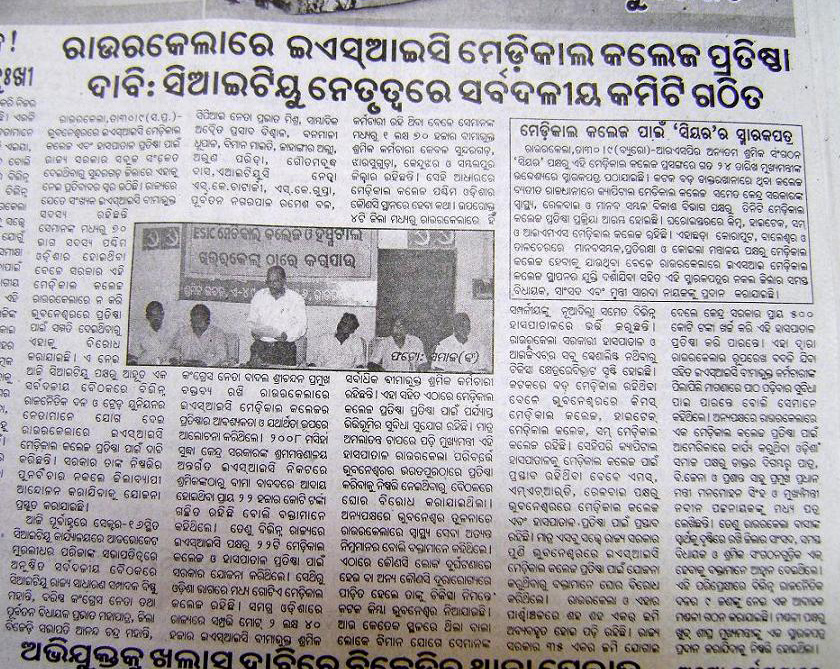
Following is from Dharitri. (Thanks to http://www.odiasamaja.org/ for the pointer.)
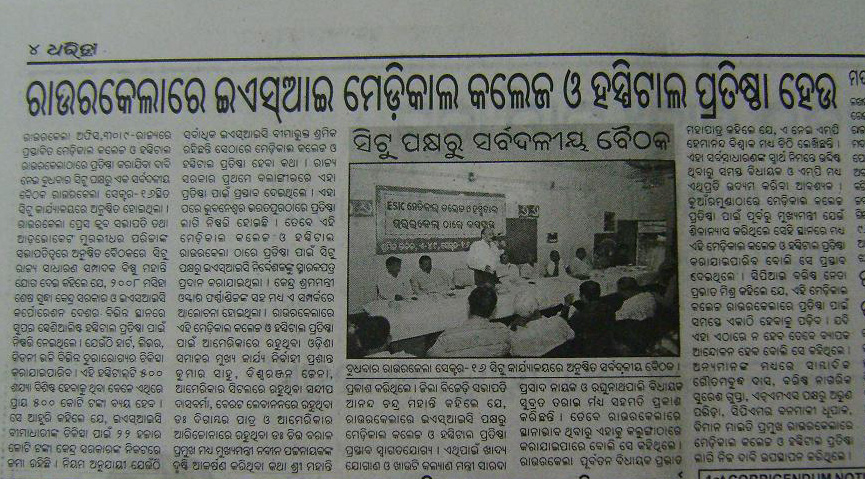
Following is from Dainik Bhaskar. (Thanks to http://www.odiasamaja.org/ for the pointer.)
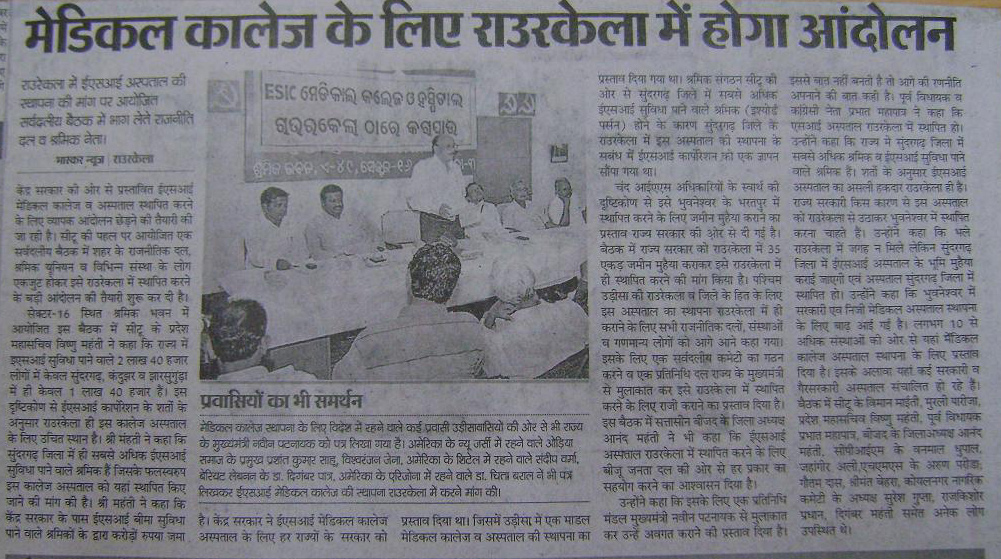
October 2nd, 2009
Update on Oct 1 2009: Pioneer has a nice article on the ESIC Medical College in Rourkela theme.
Following appeared in Sambada. Thanks to http://www.odiasamaja.org for the image.
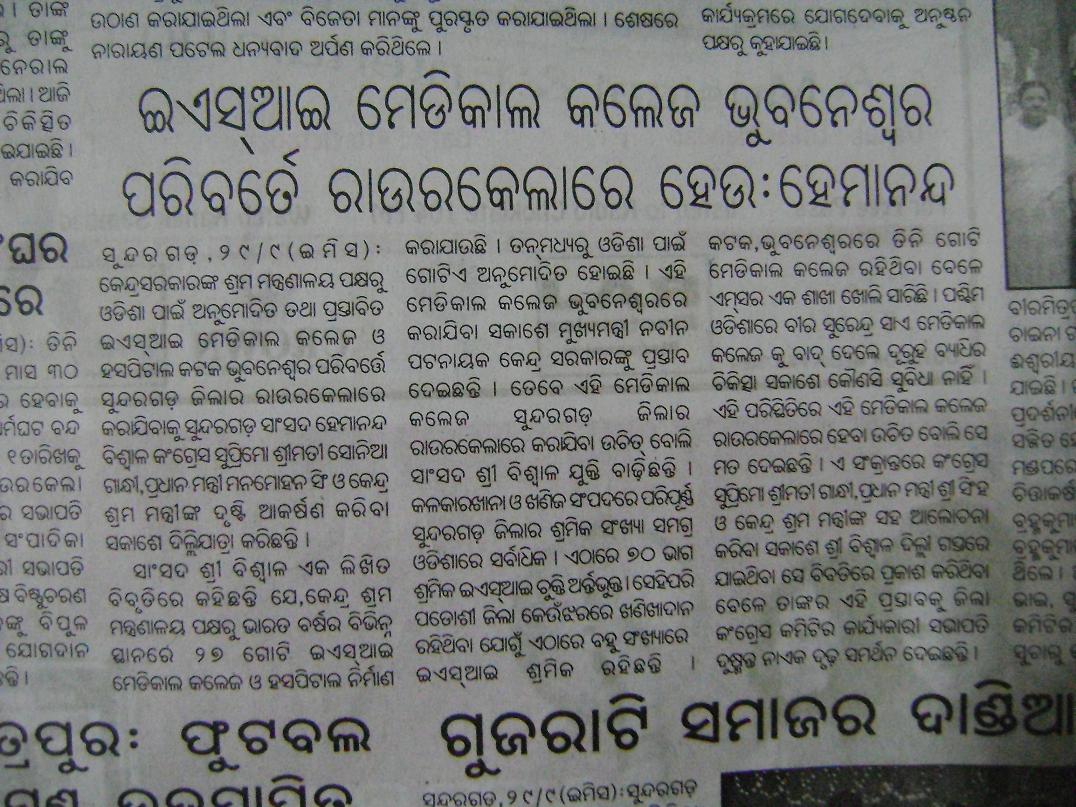
See http://www.odiasamaja.org/esic-medical-college-rkl-press-conference-report/ for a press conference that happened yesterday. Some of us participated by phone.
September 30th, 2009
Following is an excerpt from an IANS story by Prashant Nanda that we found in a report in thaiinidan.com.
… “We will retain our original name (NIT-Warangal) but it will become an integrated university with both medical and legal education among other programmes beyond engineering and technology.
“We will also provide postgraduate courses in humanities, business economics, biotechnology and many others. The focus will gradually shift to from under-graduation to post-graduation and research,” Rao explained.
NIT Warangal is the first among the NITs. It was dedicated to the nation by the first prime minister Jawaharlal Nehru way back in 1959. Then it was known a regional engineering college. The institute is older than many IITs, including IIT-Delhi.
… The director said the institute, which started its journey with a little over 100 students from a temporary campus, now boasts of 4,200 students. In 2006, the institute had 2,000 students of which 1,600 were pursuing B.Tech courses and the rest M.Tech.
“While all the central government institutes are implementing the OBC (Other Backward Classes) quota in three years, we did it at one go. With an increase in the number of seats, we have shifted our focus to post-graduation and research. Out of 4,200 students, currently 1,400 are M.Tech students and 300 are PhD scholars,” Rao added.
Like the Massachusetts Institute of Technology (MIT) in the US, NIT-Warangal will become an integrated university and provide all kinds of courses to students to help the country move forward in the field of higher education, he said.
“The process of becoming a university will start from the coming academic session but it may take a few years to become a full-fledged one. We are targeting 5,000 students by 2011 and 15,000 by 2015,” Rao said, elaborating on his mega plan.
“We are planning to have the school of medical science next year. We are going to give emphasis on biotechnology and microbiology and here the school of medical science will help us grow in both research and innovation.”
NIT Roukela has recently started a program in Biotechnology and is about to start MBA. But it must go beyond and pursue a medical school.
September 29th, 2009
Pioneer reports on a letter written by Sanjib Karmee about establishing a central university in the Western part of Orissa. Following are some excerpts.
.. One such letter written to the Prime Minister, President and other top political leaders of the country including one to the Chief Minister of Orissa and members of Parliament, by Dr Sanjib Kumar Karmee of Bio-catalysis and Organic Chemistry group of the Delft University of Technology, The Netherlands, has made a fervent appeal to the powers that be to open a Central University in the Koshal region.
He has appreciated the efforts of Ministry of Human Resources and other Central Government ministries in the establishment of many centrally funded institutions in Orissa keeping the backwardness of the State in mind.
He has cited that the current Government of the State is adopting a capital centric approach, clustering Bhubaneswar with National Institute of Science Education and Research (NISER), Indian Institutes of Technology (IIT), All India Institute of Medical Sciences (AIIMS), and Railway Medical College.
The State Government has chosen only two such centrally funded institutes outside Bhubaneswar-Cuttack-Puri region of having a Central University at Koraput in south Orissa and a proposal to set-up the Indian Institute of Information Technology in Berhampur which is also in south Orissa.
Koshal region he writes is one of the most backward regions in Orissa, and has demanded the establishment of centrally funded institutes in Koshal region. At the same time he writes about the connectivity and amenities of the region which has infrastructural readiness to have a Central University, besides he says the region has two universities – Sambalpur University and VSS University of Technology – a Government Medical College, and a few private engineering colleges. Rourkela city which is close to Burla-Sambalpur-Jharsuguda area has a National Institute of Technology at Rourkela. On connectivity he writes there is a proposal by the Government of India to have an airport at Jharsuguda and further that Jharsuguda is well connected by rail to the various States in India. Burla-Sambalpur-Jharsuguda area is emerging as a central location for on going industrial activities in the region.
Since MHRD is very serious about increasing the GER, I think the 12th plan would include some more central universities (or at the worst case universities that are funded 50-50 by center and state). Also, as I mentioned earlier, many states have regions which have been left out of the national university (mostly went to the state capital or the 1st or 2nd most populated metro area of the bigger states; but all went to metro areas with a population of greater than 1 million; the obvious reason seems to be the vision behind these universities as stated in the first announcement as well as in the concept papers) and first central university distributions (many went to smaller places of the states), and they would like to have a central university/institution. This includes Nagpur in Maharastra, Kadapa in Andhra Pradesh, Durgapur/Asansol/Siliguri in West Bengal, Bhawanipatna/Jharsuguda/Rourkela in Orissa etc.
In Orissa, after CUO Koraput and national university in Bhubaneswar, the government should strongly consider a location in its Western part (and far from Bhubaneswar) for that. Among the possible locations, a sentimental favorite would be Bhawanipatna, as it has been reported that at one point the CM had assured the representatives from Kalahandi regarding locating the first central university there. Other good locations could be Rourkela (a bit in the corner though; but is a metro and has a sizable population and does not have a regular university; it does have NIT) and Jharsuguda (lots of industrial development happening here, not too far from Rourkela, but close to Sambalpur which has two universities; But Jharsuguda itself has nothing and is going to have an airport soon).
September 24th, 2009
Following is from Samaja.
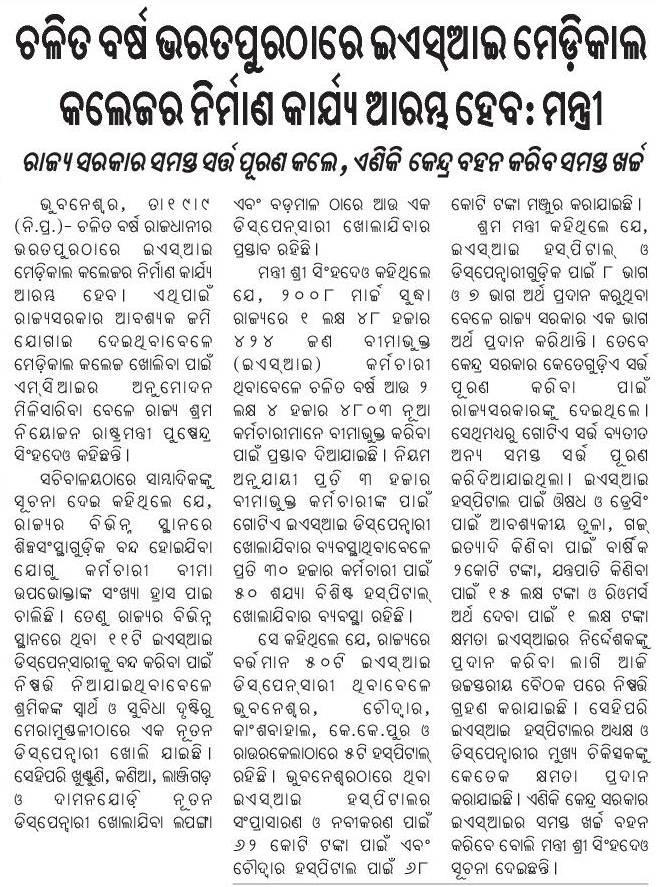
Sambada pinpoints the location as "near Institute of Mathematics & Applications."
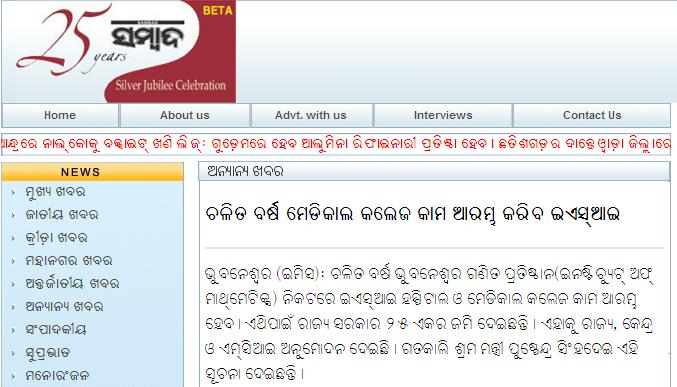
Overall the only new part here is the exact location of the land as when we started our campaign for ESIC medical college in Rourkela (in the end of August) we already knew that land had been allocated in Bhubaneswar.
So what do we do now?
Following are my suggestions.
- We need to continue pushing our case through emails, faxes, letter writing campaigns, ground level actions etc.
- We need to get the MLAs from the Rourkela area involved. They need to meet the CM and make the demands. Alternatively or in addition some civil society group needs to get an appointment with the CM and convey the demand for an ESI medical college in Rourkela.
- The MLAs around Rourkela and email/phone of some of them that I could find are:
- Rourkela – Sarada Nayak (BJD) sarada59@rediffmail.com
- Biramitrapur – George Tirkey (Independent) 0674-403599; 0661-643282
- Raghunathpali – Subrat Tarai (BJD)
- Rajgangpur – Gregory Minz (Congress)
- Bonai – Bhimsen Choudhury (BJP)
- Sundergarh – Jogesh Singh (Congress)
- Talsara – Dr. Prafulla Majhi (Congress)
- Kuchinda – Rajendra Chhatria (Congress)
The MP and ex-MP who can also meet the CM are:
- Hemanada Biswal – 09937350289
- Jual Oram – jualoram@rediffmail.com, jualoram@hotmail.com
- When these groups meet the CM they also need to have alternative proposals and an alternative set of demands. (This is in case the CM’s first response is that the land has been allotted and it can not be shifted at this stage.) Shifting of location once announced is extremely difficulty and a political hot potato. That is because if something is shifted from location A to B there will be people in A who will complain and no politician would want to do this. When A is Bhubaneswar it is even harder. (I also think that demanding shifting is not a good idea unless it is done by people of A. That is because it unnecessarily pits people of A against people of B. We on purpose never did it in case of NISER or IIT and as a result received political support from MPs and journalists of other states.)
- However, asking for an ESI medical college in Rourkela does not necessarily mean shifting the one announced in Bhubaneswar. The people meeting the CM, and at some point in our campaign, we should more forcefully point out that in other states in addition to the undergraduate medical college of ESI, 1 or more other locations will have post-graduate courses and in Karnataka there will be two ESI medical colleges. If we are able to convince this to our CM and if he demands to the center that ESI establish another medical college in Rourkela or at least PG teaching at its hospital in and around Rourkela then the chances of success are much high. But this need not be done now. We may continue with our current approach (with less badmouthing of Bhubaneswar) for some time. In this I suggest the approach and tone in here rather than the tone in the petition.
- Whether it is demanding something from the center or getting something for a region in Orissa, getting the CM on our side is most important. From past experience the best approach for getting something for a region in Orissa has been for a delegation of MLAs to meet the CM. Hence the list of MLAs above.
- With respect to fighting for Rourkela this should be just a beginning. The MLA delegation when they meet the CM should also ask the CM for
- a general state university and
- to push SAIL to establish a medical college and a engineering college, as it is doing in Bokaro. There are some technical hurdles but effort is on to overcome them. SAIL is up for its mine renewal in Orissa. See here and here. So this is the right time to do it. If SAIL Bokaro can make a medical college in Bokaro why can not SAIL Rourkela in Rourkela.
- These could be the alternative proposals that the delegation can propose to the CM.
September 20th, 2009
The duration of the 11th plan is from 2007-2012. We are now in 2009 and very soon 2012 will be looming. My guess is that the planning commission may already be in its preparatory stage to start planning for 2012. Considering that one of the big focus of this government is to increase the GER (gross enrollment ratio) in higher education from 12.4% to 30% by 2020, the 12th plan will also pay significant attention to higher education. The national knowlede commission has also recommended that India have up to 50 national universities and 1500 universities. With that in mind, following is part of something that I wrote to Prof. Yash Pal (and copied to to Sam Pitroda) in June as a response to Prof. Yash Pal’s draft. (Prof Yash Pal replied back saying: "I thank you for your excellent and concerned suggestions. I have shared them with some of my colleagues. I am sure they would be taken up by some of them. Our report will be submitted in a week. Then will start another phase. Many of these will keep reverberating. Thank you again.")
ii) Regional Universities with 50-50 split between state and the center:
The Central government now has central universities and is proposing 14 national universities. In these universities the students are and will be from across the country and the universities will be funded 100% by the central government, except land being given by the state.
As you have noted some of the centrally managed universities and institutes (IITs, etc.) have a good structure and are doing the best.
As a way to transfer this first-hand to the states I propose the establishment of “Regional Universities” which are funded 50-50 by the state and the center and the students are 50-50 between the state and the rest of the country. This will be similar to the structure of the erstwhile “Regional Engineering Colleges (RECs)”, which have now been transformed to NITs. The original RECs were funded 50-50 by the state and center and had 50-50 students from the state and the rest of the country. The NITs are funded 100% by the center.
Eventually the regional universities may be funded 100% by the center. This idea has many benefits:
(a) The direct collaboration between a state and the center helps in the transfer of know-how of how to develop and manage a good university.
(b) It costs less for the center to create another 30-40 good universities, as the cost is shared 50-50.
(c) It helps develop additional knowledge centers in the states. (Most RECs were established in second rung cities in their respective states. REC/NIT in Orissa is in Rourkela, in Tamil Nadu it is in Trichy, in Maharashtra it is in Nagpur, in Karnataka it is in Surathkal, in West Bengal it is in Durgapur, etc.)
I think this is something feasible and should be pushed with the planning commission. Even with the new central universities and national universities many states have large metropolitan areas that did not get one and are in need of a good (at least partially) centrally funded institution and university. That gap can be filled with the above proposed regional universities. In Orissa possible location of such a regional university could be Rourkela or Jharsuguda.
The proposed national universities also had stringent criteria attached to them, which made it difficult to distribute them. For example, the PIB announcing them said:
As regards 14 Central Universities aiming at world class standards, it has been considered necessary that these are located in or near selected large cities which would automatically have the kind of connectivity and infrastructure which such universities would need.
Earlier reports mentioned prime locations being an important factor and gave an example criteria of what they meant by a prime location. They cited proximity to CSIR labs.
Like the erstwhile RECs, the proposed regional universities need not have such stringent conditions allowing them to be located in places like Durgapur, Kadapa, Rourkela, Jharsuguda, etc.
Another item that I had in my mail to Prof. Yash Pal, which should be pushed for the 12th plan is as follows:
(vi) University and local communities; National and regional libraries:
I think a good library should be an integral component of each of the universities. Currently the libraries in most universities and colleges in India are pathetic. While the libraries are improved it should also mandate that a big part of the library materials, should be available for browsing for common folks who are not necessarily enrolled in the university. In the US any one can walk into a university library, be it Berkeley (a state university) or Stanford (a private university). I am not sure if that is the case with respect to the universities and colleges in India.
While we are discussing libraries, like central universities and national universities, the Indian government should establish a national library in each state capital (100% funded by the central govt.), and a regional library (funded 50-50 by the state and the central govt.) in another city of a state. In 5-10 years there should be good libraries in each district and in 10-15 years in each block. (When I walk into the local library in the US, I envy not growing up in the US and recall having to beg my local book store in a cabin near my house in Bhubaneswar to lend me translations of the world literature book series. I could not afford to buy them. Nor did my school have them.)
A new item that I have mentioned once in a while and that can be genarlized for the 12th plan is to establish centrally funded rural technological institutes like SLIET (Sant Longowal Institute of Engineering and Technology) in Punjab and the recently proposed ABA Ghani Khan Choudhary Institute of Engineering and Technology in West Bengal, in each of the other major states of the country. In Orissa, Balangir and Kalahandi (Bhawanipatna) are good possible locations for this. (Orissa should aim for having a centrally funded institute in each of the undivided KBK+Kandhamal districts.) Although centrally funded, these institutes are different from the NITs. The PIB release in the context of ABA GKC IET says the following:
The Institution will offer courses in Engineering and Technology to cater to the various manpower requirements of the region, with special emphasis on courses relevant to the local population such as in food technology & sericulture.
Initially, the Institution would start with Certificate level courses leading to Diploma, Degree and Post-graduate levels later.
The total project outlay of the Institute will be around Rs. 97 crores.
Dear Readers: Please suggest your thoughts and ideas on the 12th plan. Even if your main interest is about your home town, think of a way to put it in national terms.
September 14th, 2009
Next Posts
Previous Posts


